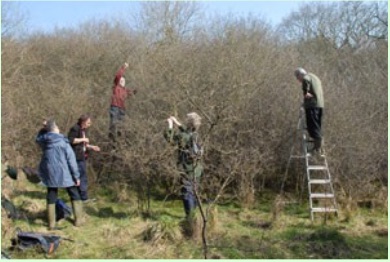 | Butterfly Conservation Saving butterflies, moths and our environment | Upper Thames Branch |  |
Hairstreak Egg Hunts | ||||||||
| There are no egg hunts scheduled at present. | ||||||||
An important aspect of the UTB's annual butterfly recording effort takes place during the winter months when we carry out regular searches for eggs of the Brown Hairstreak and Black Hairstreak.
The once widespread Brown Hairstreak declined significantly during the twentieth century and is now a UK BAP (Biodiversity Action Plan) species that exists in only seven or eight population centres spread across the southern half of England and Wales. Our local population, one of the smallest by area, is centred roughly on Bernwood Forest and straddles the Buckinghamshire and Oxfordshire border. On the wing from late July until early October, the butterfly itself can be very difficult to find because of the amount of time it spends up in the tree canopy. The Black Hairstreak exists exclusively on the band of heavy clay soils lying between Oxford and Peterborough. Although significantly less abundant than the Brown Hairstreak, the butterfly currently has no UK BAP status because its population is seen as being relatively stable. Our local colonies account for about half of the entire range of the species and are spread across a number of discrete sites between Oxford and Milton Keynes. The butterfly has a very short flight period, lasting for about three weeks in June, but its relatively sedentary lifestyle on the blackthorn means that it can be much easier to see than the Brown Hairstreak. Searching for eggs of the Brown Hairstreak during the winter months is the best method of establishing the range and health of the species. Once the leaves have dropped, the creamy-white eggs are relatively easy to find on recent blackthorn growth simply using the naked eye, although it is worth checking each egg with a hand lens because there are a couple of species of moth whose eggs can fool the unwary.
In direct contrast, because so few are ever found, searching for Black Hairstreak eggs is more of a "fun thing to do" than an activity which serves much practical purpose! The eggs are particularly difficult to spot, even to the practiced eye. Having more of a grey-white colour and shaped a bit like a doughnut, they somehow seem to be far better camouflaged on the blackthorn. The butterfly is also less fussy about where its eggs are laid. While some have been found in similar positions to those of the Brown Hairstreak on the younger blackthorn growth, others have been discovered on quite broad stems well inside a thicket and occasionally on branches at well above head height. Our Brown Hairstreak egg searches have evolved into three different kinds of activity. Checking out ("re-egging") the already known extent of the butterfly's range is generally a solitary occupation, involving a few individuals travelling around on their own in their cars, looking for a likely roadside spot in a particular kilometre square, finding an egg and then moving on to the next square. This is how the majority of the distribution map is reconfirmed each year. Finding new squares on the edge of the range can be a combination of this technique and the use of organised "hit squads", groups of branch members sent in to scour the hedgerows of a particular area, sometimes at the request of a landowner keen to add the species to his or her plans to gain environmental stewardship payments. The third activity is an annual "transect", involving a group search of specific hedgerows at a particular core location. These sites include the Otmoor RSPB reserve and Shotover Country Park in Oxfordshire as well as Wildlife Trust meadows at Bernwood and Rushbeds in Buckinghamshire. The events are normally advertised as field trips on the website and in the branch newsletter. Some of them can yield well in excess of a hundred eggs for just a couple of hours work. Black Hairstreak egg searching is usually confined to one annual visit to Finemere Wood in Bucks, from which even the experts go away happy if a single egg is found. |
Privacy and Copyright Statement
Butterfly Conservation : Company limited by guarantee, registered in England (2206468)
Registered Office: Manor Yard, East Lulworth, Wareham, Dorset, BH20 5QP, Tel: 01929 400 209
Charity registered in England & Wales (254937) and in Scotland (SCO39268)




